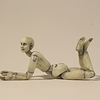Hi there exerts!
I am at the start of what I hope will be an adventure in 3D printing and am seeking advice. I want to find another way to manufacture (and refine the design of) a project I’ve modelled by hand, and cast in a really laborious process in my workshop.
The project is an articulated doll in 33 separate parts. The doll is only 14cm tall. The parts fit together by hinge joints, (based on a sphere in slices with a rod through, and ‘swivel’ where one cylinder fits into a cylindrical hole (sorry but I don’t know the tech terms for this). I’ll send a photo if you need one but don’t want an un-invited image to filter out my email You can have a look at Twelvemo on my website to see images: http://www.sarahbeare.com/page4.htm 29
The parts have to ‘grip’ and fit together tightly so the figure holds its poses. The material I want to use for casting needs to be strong and not brittle. It should be pale ivory, or white-ish in color. And I like the idea of clear resin, but some printers (daylight ones) don’t offer clear resin.
I like the idea of solid prints, not hollow, because the weight of the object in the hand is part of its charm. I know this will put up costs of material, but by how much? The complete figure weighs 33 grams.
I need the surface to be smooth and very highly detailed. I don’t mind applying colored or other finishes to the parts but I don’t want to have to sand or fill to smooth them.
I think I probably need an SLS / DLP system, for the high detail and smooth finish, but maybe an FDM machine would be able to do the job, if I can get the right specifications and material to print with!
A budget up to about GBP 2500 or USD 3000 might be about right. I have been offered help to fund this and need to do the research and show my esteemed patron what the options are, and be sure I get the right thing for my purposes, both in terms of the technology of the machine, the design software and the materials I can use.
I am reasonably competent and computer savvy, got my own laser cutter (Epilog) and use both MAC and PC laptops. Am currently learning the basics of Blender and Sculptris for my project, and would quite like to stick with these progras to build if I can. Will obviously want to design other things but they’ll all be pretty small in general. I’m based in the East of England.
Any advice you can give me would be very much appreciated.
created
Dec '16last reply
Dec '16- 10
replies
- 5.3k
views
- 4
users
- 3
likes
- 1
link
